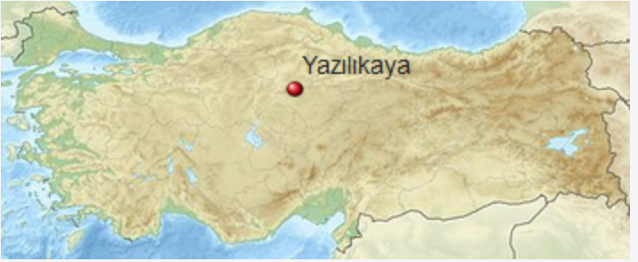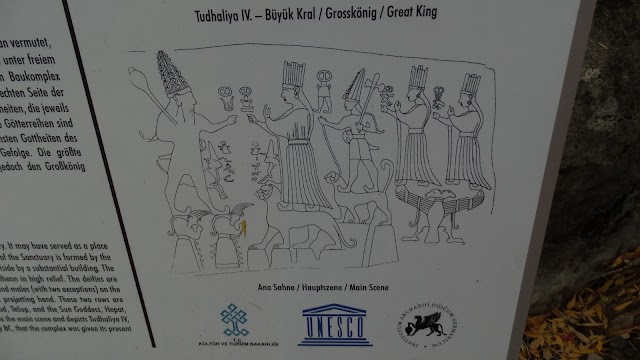Yazilikaya - Holy sanctuary at the Hittite capital of Hattuša
 |
Yazilikaya (meaning 'inscribed rock' in Turkish), is an ancient Hittite sanctuary, situated in some low-lying hills next to the small town of Bogazkale about 170 kilometers east of Ankara. It's an open air shrine nestled in some rocks where a spring of fresh water once flowed - perhaps a place of worship for hundreds or thousands of years before the Hittites rose to power.
The region of Bogazkale had been settled during Paleolithic times but the first real evidence of occupation dates from the first half of the 3rd millennium BC. From old Assyrian texts and from a later, Hittite, document it is known that a city called Hattush was founded around 1900 BC by the Hati culture.
Around the 17th century BC, the Hittites descended from the north and overcame the indigenous Hati people, probably incorporating much of that culture into their own. They conquered the city of Hattush, renaming it Hattusha, and made it the capital of their own empire. The Hittites rapidly became a major power, rivaling Mesopotamia and Egypt. We know from objects of trade, treaties and clay tablet records of their letters that they had contact with Mycenae, Troy and dynastic Egypt. Hattusha remained the capital of the Hittite empire until its mysterious decline around 1200 BC.
It was not until 1909 when archaeologists discovered the city of Hattusha, and its library with thousands of clay tablets, that it was possible to trace these lost people. Excavations of their city revealed a large and powerful culture that was ruled by written laws, had created palaces and fortifications, enjoyed a fixed monetary system, and had developed a religion with its own gods and goddesses. The Hittites were polytheist and together with their own gods and goddesses they also worshipped deities deriving from other Mesopotamian cultures. Records of Hattusili, the first Hittite king who resided at Hattusha, tell of temples dedicated to a sun goddess called Arianna and her daughter Mezulla as well as a weather god named Teshub.
My basic motivation was to view the carved rock
 |
| cliff_emerson© Above, a close-up photo of the Twelve Gods of the Underworld - carved relief in rock wall. |
 |
| Cliff_Emersonç |
Here are all 12 gods, including the first one (right side) which is covered with a dark, soluble substance that flowed across it from the rock over time.
 |
| cliff_emerson© |
Yazılıkaya is located in north-central Turkey, north-east of the capital city, Ankara.
The shrine was built more than 3000 years ago.
Historians suggest that the elite of the Hittite society, an empire that dominated what is now central and south-central Turkey between 1700 and 1100 BC until it was destroyed, created the Yazılıkaya shrine to embody their ideas about how the universe was organized.
“There are many connotations with the names of the deities and the arrangements and groups, and so in retrospect it’s pretty easy to figure it out,” says Eberhard Zangger, president of Luwian Studies, an international non-profit foundation. “But we worked on it for seven years
 |
| https://followinghadrianphotography.com/category/turkey/hittite/ |
The most impressive area is Chamber A, which contains rock-cut relief of 64 deities in procession. The left wall shows a procession of male deities, wearing the traditional kilts, pointed shoes and horned hats. Mountain gods are also shown with scaled skirts to symbolise the rocky mountains. The right wall shows a procession of female deities wearing crowns and long skirts. The only exception to this divide is the goddess of love and war, Shaushka (Mesopotamian goddess Ishtar/Inanna) who is shown on the male procession with two female attendants. This is likely to be because of her male attributes as the goddess of war.
 |
| cliffemerson© |
The processions lead to a central scene of the supreme couple of the pantheon: the storm-god Teshub and the sun-goddess Hebat. Teshub stands on two mountain gods whilst Hebat stands on a panther. Behind Hebat are shown their son Sharruma, daughter Alanzu and a granddaughter.
 |
| cliff_emerson© |
The smaller and narrower Chamber B has fewer but larger and better preserved reliefs. It may have served as a mortuary mausoleum or memorial for the Hittite king Tudhaliya IV.
 |
| cliff_emerson© |
The Hittite practise of assimilating other cultures' gods into their own pantheon is in evidence at Yazilikaya. The Mesopotamian god of wisdom, Ea (Enki) is shown in the male procession and the god Teshub was a Hurrian god who was syncretized with the Hittite storm-god. Hebat's original consort was changed into her and Teshub's son (Sharruma) and she was later syncretized with the Hattic Sun goddess of Arinna. It is believed that Puduhepa, who was the daughter of a Hurrian priestess and the wife of the Hittite king Hattusili III, also played a role in the increasing Hurrian influence on the Hittite religion.
 |
| cliff_emerson© |
A 2021 study concluded that the sanctuary depicted the cosmos including its three levels: earth, sky, and underworld; in addition to the cyclical processes: day/night, lunar phases, and summer/winter, which served as a lunisolar calendar. However, the supreme deities in Chamber A, referred to the northern stars, while Chamber B represented the netherworld.
 |
| cliff_emerson© |
 |
| cliff_emerson© |
 |
| cliff_emerson© |
(So sorry. I will work on completing this section soon.)
 |
| cliff_emerson |











No comments:
Post a Comment